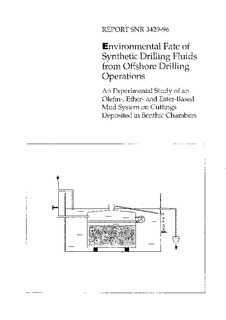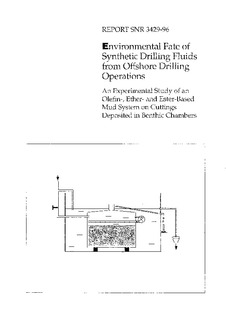| dc.contributor.author | Schaanning, M. | nb_NO |
| dc.contributor.other | Schaanning, M. - Project manager | nb_NO |
| dc.coverage.spatial | North Sea | nb_NO |
| dc.date.accessioned | 2014-08-01T10:39:12Z | |
| dc.date.available | 2014-08-01T10:39:12Z | |
| dc.date.issued | 1996 | nb_NO |
| dc.identifier | 3429 | nb_NO |
| dc.identifier.isbn | 82-577-2963-9 | nb_NO |
| dc.identifier.issn | 1894-7948 | nb_NO |
| dc.identifier.uri | http://hdl.handle.net/11250/208757 | |
| dc.description.abstract | Synthetic drilling fluids have replaced much of the mineral oil previously used in mud systems for off-shore drilling operations. The chemicals are entered into the North Sea environment attached to bore hole cuttings, which are deposited on the seabed not far from the discharge sites. After deposition, erosion may occur by biodegradation, bioturbation, resuspension and release to the watermass of dissolved chemicals or metabolites. In the present investigation, aliquots of control sediment and three types of cuttings were deposited in duplicate benthic chambers. During an experimental period of 161 days, the loss of drilling fluids from the sediments as well as the change of the ratio between drilling fluid and barium was measured. The mineralisation of drilling fluid carbon to CO2 and water was calculated from oxygen consumption measurements and effects on sediment pH and redox potentials were determined at various time intervals. The results showed that Novasol II polyalfaolefins and Aquamul ethers degraded more slowly than Petrofree esters. However, as shown by strong redox potential deviations, the availability of the esters to sulphate reducing bacteria will most likely reduce the diversity of benthic communities during the degradation period. | nb_NO |
| dc.description.sponsorship | Saga Petroleum A/S | nb_NO |
| dc.publisher | Norsk institutt for vannforskning | nb_NO |
| dc.relation.ispartofseries | NIVA-rapport;3429 | nb_NO |
| dc.rights | Navngivelse-IkkeKommersiell-DelPåSammeVilkår 3.0 Norge | nb_NO |
| dc.rights.uri | http://creativecommons.org/licenses/by-nc-sa/3.0/no/ | nb_NO |
| dc.subject | olje og gass | nb_NO |
| dc.title | Environmental Fate of Synthetic Drilling fluids from Off-shore Drilling Operations - An Experimental Study of an Olefin-, Ether- and Ester-Based Mud System on Cuttings Deposited in Benthic Chambers | nb_NO |
| dc.type | Research report | nb_NO |
| dc.rights.holder | Norsk institutt for vannforskning/Norwegian institute for water research | nb_NO |
| dc.subject.nsi | VDP::Matematikk og naturvitenskap: 400 | nb_NO |
| dc.source.pagenumber | 55 | nb_NO |
| dc.subject.keyword | oljeboring | nb_NO |
| dc.subject.keyword | kjemikalier | nb_NO |
| dc.subject.keyword | nedbryting | nb_NO |
| dc.subject.keyword | sediment | nb_NO |
| dc.subject.keyword | oil | nb_NO |
| dc.subject.keyword | drilling | nb_NO |
| dc.subject.keyword | chemicals | nb_NO |
| dc.subject.keyword | degradation | nb_NO |
| dc.subject.keyword | sediments | nb_NO |
| dc.relation.project | O-94066 | nb_NO |


